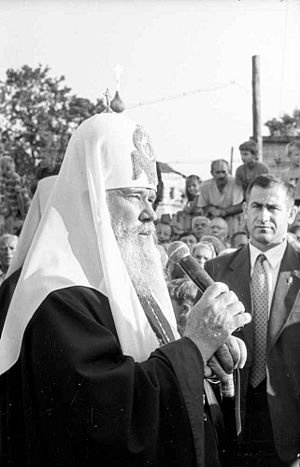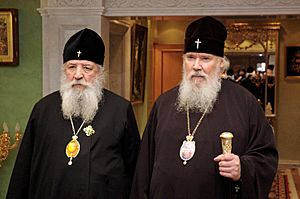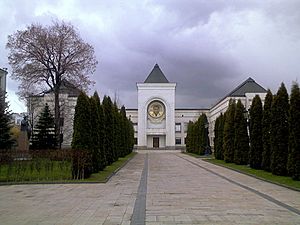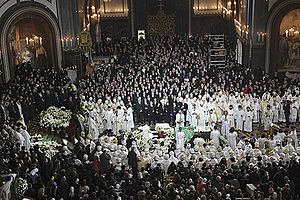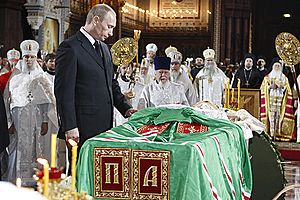Patriarch Alexy II of Moscow facts for kids
Quick facts for kids Alexy II |
|
|---|---|
| Patriarch of Moscow and all Rus' | |
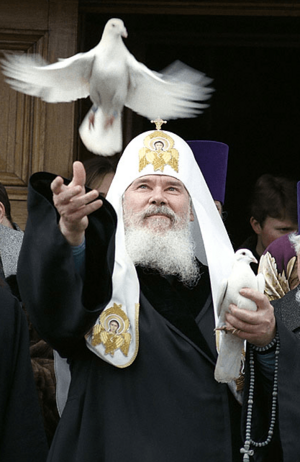 |
|
| Church | Russian Orthodox Church |
| See | Moscow |
| Enthroned | 10 June 1990 |
| Reign ended | 5 December 2008 |
| Predecessor | Pimen I |
| Successor | Kirill I |
| Orders | |
| Ordination | 17 April 1950 |
| Consecration | 3 September 1961 by Nikodim of Leningrad |
| Personal details | |
| Birth name | Aleksei Rüdiger |
| Born | 23 February 1929 Tallinn, Estonia |
| Died | 5 December 2008 (aged 79) Peredelkino, Moscow, Russia |
| Buried | Epiphany Cathedral at Elokhovo |
| Nationality | Russian |
| Denomination | Russian Orthodox |
| Spouse | Vera Alekseeva (1950–1951) |
| Signature |  |
| Coat of arms |  |
Patriarch Alexy II (also known as Alexius II) was the 15th Patriarch of Moscow and all Rus'. This means he was the main leader of the Russian Orthodox Church.
He was chosen as Patriarch in 1990. This was about a year and a half before the Soviet Union broke apart. He became the first Russian Patriarch in the time after the Soviet Union.
Contents
Who was Alexy II's family?
Alexey Mikhailovich Ridiger came from a noble family of Baltic Germans. His father, Mikhail Aleksandrovich Ridiger, was a descendant of Captain Heinrich Nikolaus Rüdinger. This captain was honored by King Charles XI of Sweden in 1695.
Later, areas like Swedish Estonia became part of the Russian Empire. One of Alexey's ancestors, Friedrich Wilhelm von Rüdiger, became Orthodox Christian.
After the October Revolution in 1917, Alexey Ridiger's father, Mikhail, became a refugee. His family settled in Estonia. Mikhail later moved to Tallinn, Estonia's capital. There, he married Yelena Iosifovna Pisareva in 1928.
Alexey's father finished theological seminary in Tallinn in 1940. He became a deacon and then a priest. He served as the leader of the Church of the Nativity of the Mother of God in Tallinn.
Alexy II's Life Story
Early Years in Estonia
Alexey Ridiger was born in the Republic of Estonia. This country became a spiritual home for many Russians after the 1917 October Revolution. He was baptized into the Estonian Apostolic Orthodox Church.
From a young age, Alexey served in the Orthodox Church. He was guided by his spiritual father, Archpriest Ioann Bogoyavlensky. He also went to Tallinn's Russian Gymnasium.
When the Soviet Union took over Estonia in 1940, Alexey's family was on a list to be arrested. They were supposed to be sent away from Estonia. But they hid in a small hut and were not found by the NKVD (Soviet secret police).
During the time when Nazi Germany occupied Estonia (1941–1944), Alexey and his father visited Soviet prisoners of war. These prisoners were in German camps in Estonia. The German authorities allowed this because it was seen as anti-Soviet. After Soviet forces returned to Estonia in 1944, the Ridiger family chose to stay. Most people with Baltic German roots left for the West.
During World War II, Joseph Stalin allowed the Russian Orthodox Church to become active again. The Alexander Nevsky Cathedral, Tallinn had been closed during the war. It reopened in 1945 after the Soviets took over Estonia. Alexey Ridiger became a Soviet citizen. He served as an altar boy in the cathedral from May to October 1946. Later that year, he became a psalm-reader in St. Simeon's Church. In 1947, he worked in the same role at the Church of the Kazan Icon of the Mother of God in Tallinn.
Becoming a Priest
Alexey entered the Leningrad Theological Seminary in 1947. He finished there in 1949. Then he went to the Leningrad Theological Academy, graduating in 1953.
On April 15, 1950, he became a deacon. Two days later, on April 17, 1950, he became a priest. He was appointed the leader of the Theophany church in Jõhvi, Estonia.
In 1957, Father Alexy became the leader of the Dormition Cathedral in Tallinn. He also became the Dean of the Tartu district. He was made an Archpriest in 1958. In 1959, he became Dean of the combined Tartu-Viljandi area. On March 3, 1961, he became a monk at the Trinity Lavra of St. Sergius.
When he became a monk, his name (Alexey) stayed the same. But his patron saint changed from Alexius of Rome to Alexius, Metropolitan of Kiev.
Serving as a Bishop
On August 14, 1961, Alexy was chosen to be the Orthodox Church Bishop of Tallinn and Estonia. He became an archbishop in 1964. In 1968, at age 40, he was made a metropolitan.
From 1964, Alexy was one of the leaders of the Conference of European Churches. He was elected President of its main committee in 1987. He stayed in this role until 1990.
The Church in Soviet Times
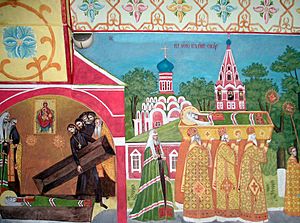
During the Soviet era, the government controlled many parts of life, including religious groups. To keep the Church going, its leaders sometimes had to make agreements with the Soviet authorities.
Reports from the 1990s suggested that Patriarch Alexy II had cooperated with the KGB (the Soviet secret service). These reports came from a person who had access to secret KGB files. He claimed that some high-ranking church leaders, including Alexius II, had worked with the KGB.
Patriarch Alexy II admitted that church leaders, including himself, had to make compromises with the Soviet government. He publicly asked for forgiveness for these actions. He said:
- "To protect one thing, it was necessary to give somewhere else. Were there any other organizations, or any other people who had to take responsibility not only for themselves but for thousands of other lives, who in those years in the Soviet Union were not forced to act in a similar way? To those people, however, who were hurt by the compromises, silence, forced inaction, or expressions of loyalty allowed by church leaders in those years, to these people, and not only before God, I ask for forgiveness, understanding, and prayers."
He also said that reports calling him a "KGB agent" were just exaggerations of the necessary compromises he had to make. An official church spokesman also said these reports were "absolutely without proof."
It was known that the Soviet government had to approve any candidate for a high church position. This included bishops and members of the Holy Synod.
Many historians agree that some level of cooperation with Soviet authorities was needed for bishops to protect their people and stay in office. Alexy himself said that as bishop of Tallinn in 1961, he stopped the communists from turning a cathedral into a planetarium. He also prevented a nunnery from becoming a rest home for miners. Records show that during his time as bishop, fewer churches were forced to close in his area compared to other parts of the USSR.
Becoming Patriarch
After Patriarch Pimen passed away in 1990, Alexy was chosen as the new Patriarch of the Russian Orthodox Church. He was picked because of his experience and was seen as smart and hardworking. People thought he could bring different groups within the church together.
Patriarch Alexy II was the first patriarch in Soviet history chosen without government pressure. Candidates were nominated openly, and the election was by secret ballot.
As Patriarch, Alexy II spoke strongly for the rights of the church. He asked the Soviet government to allow religious education in schools. He also called for a law that would protect "freedom of conscience."
During an attempted government takeover in August 1991, he spoke out against the arrest of Mikhail Gorbachev. He questioned the new government's right to rule. He asked for the military to be calm and for Gorbachev to speak to the people. He also asked for no violence, which was broadcast to soldiers. The takeover failed, and the Soviet Union soon broke apart.
In 1995, during a visit to Germany, Alexy II apologized for the "Communist rule that had been forced upon the German nation by the USSR." This caused some Russian communists to accuse him of insulting Russia.
In 1998, Alexy II decided not to lead the burial service for the royal family. They were killed by the Bolsheviks in 1918. He had doubts about whether the remains were truly those of the royal family.
Under his leadership, many New Martyrs and Confessors of Russia were honored. These were people who suffered under Communism. This began in 1992 with Grand Duchess Elizabeth and others. In 2000, Tsar Nicholas II and his family were also honored. More names continue to be added.
Alexy II had complex relations with Pope John Paul II and the Roman Catholic Church. They disagreed about property rights of the Greek-Catholic Church in Ukraine. However, he had good relations with other Christians in France.
In 2007, Patriarch Alexy II led the reunion of the Moscow Patriarchate with the Russian Orthodox Church Outside Russia (ROCOR). The ROCOR was formed in the 1920s by Russian bishops who had to leave Russia after the Civil War. They had been critical of the Moscow Patriarchate's loyalty to the Soviet government. The two branches signed the Act of Canonical Communion on May 17, 2007.
Before this signing, there were false reports in Russian media that Patriarch Alexy II was very ill or had died. This was a trick, likely meant to stop the reunion.
Daily Life
On April 11, 1950, he married Vera Alekseeva. She was the daughter of Georgi Alekseev, who later became Bishop John of Tallinn. They divorced less than a year later.
The Patriarch's private home was in the village of Lukino, near Peredelkino, a suburb of Moscow. It had a 17th-century church and a museum. Nuns from the Pühtitsa Convent took care of the house.
He also had an office in central Moscow, a 19th-century mansion. Both homes were used for living and working. He traveled in an armored car and was protected by federal agents. The official residence was at the Moscow Danilov Monastery.
Death and Burial
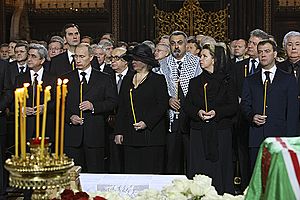
Alexy II died at his home in Peredelkino on December 5, 2008. Reports said he died of heart failure. He passed away just 80 days before his 80th birthday.
On December 7, 2008, Russian President Medvedev ordered that on the day of the Patriarch's burial, cultural and TV programs should be canceled. He also ordered help for the Patriarchate to organize the burial. This was not a formal national day of mourning.
On December 9, 2008, the funeral service for the Patriarch was led by Ecumenical Patriarch Bartholomew I at the Cathedral of Christ the Saviour. After the service, he was buried in the southern chapel of the Epiphany Cathedral at Elokhovo in Moscow.
Many important people shared their thoughts after his death:
- Russian Prime Minister Vladimir Putin said Alexy II was a "prominent figure" and a "great statesman." He also said Alexy II helped relations between different faiths.
- Toomas Hendrik Ilves, President of Estonia, remembered Alexius II as a "wise man respected by religious and non-religious people."
- The BBC wrote that Alexy II had an "extraordinary career." He went from a time when the church was suppressed to being its champion. He oversaw the "revival and flowering of the Church."
- Rabbi Arthur Schneier, an American Jewish leader, said Alexy II "served as the ethical pulse of the religious community" in the former Soviet Union.
Awards and Honors
Patriarch Alexy II received many awards and honors during his life. These came from Russia, other countries, and religious organizations.
- In 2000, he received Russia's national Man of the Year prize.
- In 2003, he received the Order of the Cross of Terra Mariana, 1st Class, from Estonia.
- In 2005, he was the first person to receive the State Prize of the Russian Federation for humanitarian work.
- In 2006, he received the highest Muslim Order of Sheikh ul-Islam from the Muslim Board of the Caucasus.
He was an honorary member of several Theological Academies. He also received honorary degrees from many universities around the world.
- Awards from the Russian Orthodox Church and other churches
- Order of St. Andrew with a diamond star
- Order "Glory and Honor" (2005)
- Order of the Holy Prince Daniel of Moscow, 1st class
- Order of St. Alexis the Metropolitan of Moscow and All Russia, 1st class
- Order of St. Macarius the Metropolitan of Moscow and All Russia, 1st class
- Order of St. Prince Vladimir Equal, 1st class (1968) and 2nd class (1963)
- Order of St. Sergius, 1st class (1979)
- Order of St. Innocent Metropolitan of Moscow and Kolomna, 1st class
- Order of Saint Blessed Prince Dimitry Donskoy great, 1st class (2005)
- Order of Saints Cyril and Methodius, 1st class (Czechoslovak Orthodox Church, 1962)
- Order of St. John of Rila, 1st class (Bulgarian Orthodox Church, 1968)
- Order of St. Mark (Orthodox Church of Alexandria, 1969)
- Order of the Holy Cross, 1st and 2nd classes (Jerusalem Orthodox Church, 1968, 1984)
- Order of St. George, 1st and 2nd classes (Georgian Orthodox Church, 1968, 1972)
- Order of the Apostles Peter and Paul, 2nd class (Antiochian Orthodox Church, 1981)
- Order of St. John the Martyr Archbishop of Riga, 1st class (Latvian Orthodox Church, 2006)
- Medal of 1,500th anniversary of the Patriarchate of Jerusalem (1965)
- Gold medal, 1st class the Holy Great Martyr Demetrius of Thessalonica (Greece, 1980)
- Gold Medal of the I degree Archdiocese of St. Catherine of Katerini (Greece, 1982)
- Medal "15 years of Kemerovo and Novokuznetsk dioceses" (Diocese of Kemerovo and Novokuznetsk, 2008)
- State awards from the Russian Federation
- Order of St. Andrew (1999) – for his work in spiritual rebirth and peace in Russia.
- Order of Merit for the Fatherland, 1st class (2004) and 2nd class (1997) – for strengthening peace and restoring heritage.
- Order of Friendship of Peoples (1994) – for his contribution to Russia's spiritual revival and peacemaking.
- State Prize of the Russian Federation for humanitarian action (2006).
- State awards from the USSR
- Order of the Red Banner of Labour
- Order of Friendship of Peoples (1979)
- Awards from Russian regions
- Order of the "Key of Friendship" (Kemerovo region)
- Order of the White Lotus (Kalmykia, 1997)
- Awards from government departments
- Commemorative Medal Gorchakov (Russian Foreign Ministry, 2002)
- Badge "For mercy and charity" (Ministry of Education and Science of the Russian Federation, 2003)
- Medal "For contributions to the development of agro-industrial complex" I degree (Ministry of Agriculture of Russia, 2005)
- Medal Anatoly Koni (Russian Ministry of Justice, 2000)
- Foreign awards
- Order of "Glory" (Azerbaijan, 2005) – for developing friendly relations.
- Order of the Cross of Terra Mariana, 1st class (Estonia, 2003)
- Order of the Three Stars, 1st class (Latvia, 2006)
- Order of Friendship of Peoples (Belarus, 2004) – for bringing cultures together.
- Order of Francisc Skorina (Belarus, 1998) – for strengthening friendly relations.
- Medal of Honour (Belarus, 2008)
- Medal of Francysk Skaryna (Belarus, 1995) – for his contribution to the Orthodox Church.
- Order of the Republic (Moldova, 2005)
- National Order of the Cedar (Lebanon, 1991)
- Order of the Lithuanian Grand Duke Gediminas, 1st class (Lithuania, 1997)
- Order Dostyk, 1st class (Kazakhstan, 2002)
- Order of the Republic (PMR, 1999) – for promoting the Orthodox faith.
- Community Awards
- Diploma and medals from the Soviet Peace Fund (various years).
- Medal of the World Peace Council (1976, 1981).
- Charter of Soviet-Indian friendship.
- KGB Certificate of Honour (1988).
- Honorary citizenship of Moscow, St. Petersburg, and many other cities and regions.
See also
 In Spanish: Alejo II para niños
In Spanish: Alejo II para niños


